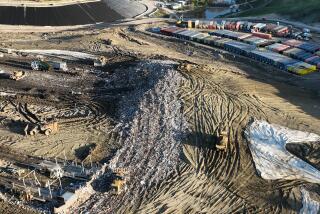Lax Monitoring of Leaks at Toxic Dumps Charged
WASHINGTON — Barely 40% of toxic-waste landfill operators have complied with a 1981 federal requirement to monitor dumps for leaks into underground water supplies, according to a survey scheduled to be released today by a House Commerce subcommittee.
The report blistered the Environmental Protection Agency for what it terms “dilatory and seriously deficient” enforcement of the monitoring standard, which was issued to combat what the EPA has called the nation’s most serious pollution threat.
Roughly half of the population relies on ground water for drinking water, and a fifth of underground water stocks already are polluted with man-made chemicals, the EPA has estimated.
The survey, ordered by Commerce Committee Chairman John D. Dingell (D-Mich.) for a hearing today on ground-water pollution, was taken to determine how many federally licensed landfills and waste lagoons had sunk wells around their disposal sites to check for contamination of underlying ground water.
The wells were supposed to have been installed and operating by November, 1981, under a federal law regulating commercial and industrial hazardous-waste sites.
According to the survey, however, adequate monitoring exists at only 508 of the 1,246 dumps and impoundments licensed to receive hazardous wastes.
In California, the survey found, only three of 98 licensed sites had adequate checks for leaks, and wells at 28 other sites were judged inadequate. At the remaining impoundments, the survey stated, either no monitoring wells had been sunk or the status of monitoring was unclear.
The report also concludes that monitoring wells are inadequate at 21 of the 39 commercial landfills nationwide receiving wastes from federal Superfund cleanups of abandoned toxic-waste dumps.
Millions of Dollars
The EPA has spent scores of millions of dollars since 1980 to ship toxic wastes excavated from Superfund dumps--the country’s most dangerous waste sites--to supposedly leak-free commercial landfills.
Among other findings, the study concluded that:
--Of the 1,246 regulated waste sites, 559 showed some evidence of leaking. EPA officials said the total may be excessive because some statistical tests for leaks yield a high number of false readings.
--The EPA does not know whether wells are adequate at 209 sites, and no wells exist at 188 sites.
--Wells were judged inadequate at 317 facilities, including 31 of 56 federally owned toxic-waste disposal sites. At 81 of the 317 inadequate facilities, the EPA has taken no action to force the upgrading of monitoring systems.
Much of that poor record appears due to red tape or other bureaucratic roadblocks. The EPA’s own computerized data bank on toxic-waste sites could not accurately determine which landfills are even subject to the law requiring ground-water checks, Dingell’s report stated.
But technical and scientific problems also have dogged the EPA’s ground-water checking efforts for years. Landfill operators often have dug monitoring wells in the wrong places to detect leaks, and they have sometimes used improper methods to test well water for toxic contamination. Even the results of properly conducted tests are often disputed for months.
Results Called ‘Shocking’
In a letter accompanying the survey, Dingell called the results of the subcommittee’s canvass “shocking.” He called for the EPA to make an “all-out effort toward obtaining immediate compliance” with the ground-water monitoring rules. The regulations were mandated by the Resource Conservation and Recovery Act of 1976.
A top EPA official told reporters last July that enforcing ground-water monitoring rules was the agency’s “number one priority.” The agency said Sunday that Dingell’s findings, while disturbing, are not especially new.
An EPA official said that the Dingell survey “reconfirms information we’ve developed ourselves over the past year.” A similar failure record was reported by the General Accounting Office, Congress’ watchdog agency, in 1983, and an internal EPA report reached many of the same conclusions in May, 1984.
“In a nutshell, the agency’s willing to concede problems with the . . . program,” David Cohen, an EPA spokesman, said Sunday. “We’d be the first to agree we’re not happy . . . but the rules and the enforcement resources are in place now, so that we’re poised for some dramatic changes.”
Congress ordered the EPA last year to close any federally licensed disposal sites that are not monitoring for leaks by this November. State environmental officials have expressed doubt that the deadline can be met, and some say a complete safety review of toxic-waste treatment, storage and disposal sites could take a decade or more.
More to Read
Sign up for Essential California
The most important California stories and recommendations in your inbox every morning.
You may occasionally receive promotional content from the Los Angeles Times.










